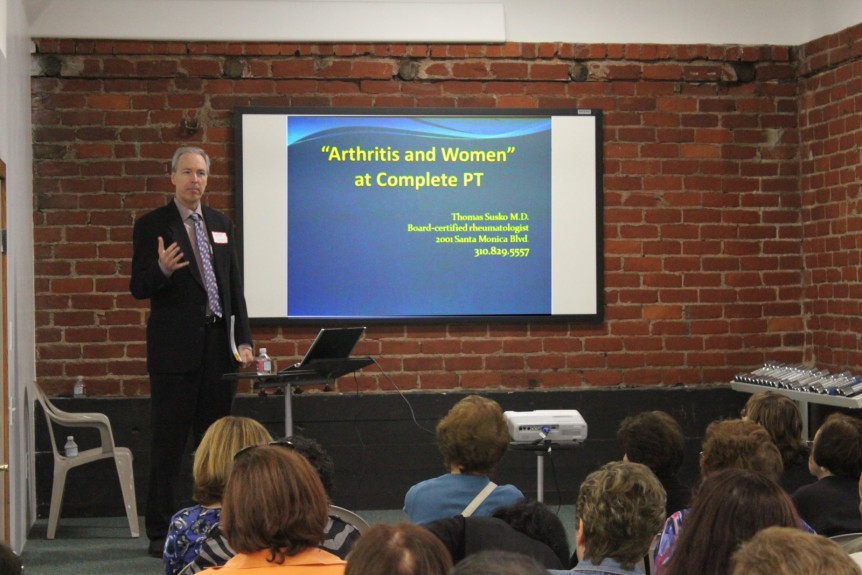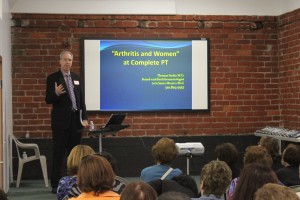As part of CompletePT’s Free Lecture Series to the community, rheumatologist Thomas Susko, M.D., of Santa Monica presented an engaging talk on osteoarthritis and rheumatoid arthritis. More than fifty people were there, all of them paying rapt attention while learning the latest information that is available in 2011.
Here are some key points made by Dr. Susko.
Osteoarthritis (OA) is the degeneration of cartilage and the development of bony overgrowth called “spurs” or osteophytes. OA is synonymous with degenerative joint disease (DJD) in which the cartilage wears down. There are mechanical factors as well as chemical factors inside the joint that can promote abnormally rapid cartilage degeneration. It affects nearly 30 million Americans, and with the Baby Boomer generation moving into their sixties, that number is sure to grow rapidly.
Three times as many women develop OA than men. The symptoms include joint pain and tenderness to the touch, stiffness in the morning or after prolonged sitting, decreased range of motion, and increased warmth. To minimize the risk of developing OA, maintain your ideal body weight, exercise daily, don’t ignore pain, which will help you avoid joint injury. Pool therapy allows for patients who have pain when exercising on land to resume activity without aggravating their affected weightbearing joints.
Research showed patients in a randomized study with an exercise program for knee or hip OA had less pain, experienced less disability, and took fewer medications. Within twelve weeks of entering the study, they also had fewer visits to their MDs. (Van Baar et al, Journal of Rheumatology, 1998)
Just published in August, 2011 in Arthritis and Rheumatism: 1000 people with knee arthritis had a device attached to measure their activity level. Inactive was defined as a failure to sustain a 10-minute period of moderate-to-vigorous activity during a week. It was found that 40.1 % of men and 56.5% of women studied were found to be inactive. More than 20 minutes of moderate intensity walking is recommended daily for adults with arthritis.
Dr. Susko discussed the drugs most likely to be used for OA then explained the risks of the drugs themselves. Acetaminophen (Tylenol) is contained in many medications but they aren’t labeled as such. Examples: Vicodin, Percocet, Ultracet, Midol, and TheraFlu. Overdoses of acetaminophen are blamed for about 26,000 hospitalizations and more than 400 deaths annually. Labels are being changed on products and safe dosages are being reduced from 4,000 milligrams to 3,000 milligrams a day.
Anti-inflammatories of all kinds increase the risk of heart attack.
- Data released from the University of Florida on July 21, 2011 by Dr. Bavry et al found that the risk of death from cardiovascular causes for 2.3 times higher among patients who chonically used anti-inflammatories than among other patients.
- In January, 2011, the University of Bern published findings in the British Medical Journal that ibuprofen (Advil, Motrin) was associated with more than three times the risk of stroke and 2.4 times the risk of heart attack. Naprosyn/Aleve have an increased risk of potentially fatal bleeding stomach ulcers when compared to other non-steroidal anti-inflammatories (NSAIDs).
- A study at Copenhagen University Hospital published the results of a study in the journal “Circulation” on May 9, 2011 using more than 83,000 patients who had previous heart attack over the age of 30. The study lasted ten years. They found a 45% higher risk of having another heart attack or dying within seven days of taking an anti-inflammatory. After taking the drugs for 30 days, the risk increased to 55-65%. Even short-term use of NSAIDs are associated with cardiovascular events.
Dr. Susko said do not to take anti-inflammatories if you have had a heart attack. Consult with your treating physician prior to making any changes to your prescribed medication.
What about Glucosamine and Chondroitin? Dr. Susko presented the results of the GAIT study (Glucosamine/Chondroitin Arthritis Intervention Trial) that was done by the National Institute of Health using our tax dollars. It was a 6-month study with 1,580 arthritis patients who had mild to moderate arthritis pain. The Glucosamine and Chondroitin didn’t offer any more pain relief than a placebo pill. This was followed by another study that lasted two years instead of only six months and there were no statistically significant differences among four treatment groups. This was published in August, 2010, in the Annals of Rheumatic Diseases.
Steroid injections work quickly to reduce pain if the degree of OA isn’t severe; however, the duration of relief may be from only a few days to a few months. The potential side effects if given repeatedly include loss of bone strength over time and can even harm the very cartilage that is trying to be saved.
What’s the future of OA treatments?
- Developing enzymes to counteract the destructive enzymes at work inside joints damaging the cartilage
- Stimulating cartilage growth factors
- Transplanting cartilage
- Pharmacogenomics: the study of different responses to drugs depending on the individual’s genetic makeup
Rheumatoid arthritis (RA) is a chronic type of inflammatory arthritis. It is an auto-immune disease, meaning that the body’s immune system perceives its own tissue as a foreign enemy and begins to fight it. RA is a destructive, systemic disease that affects nearly 3 million people in the United States, which is about 1% of the adult population. The cause for RA isn’t known, but there are most likely genetic and environmental factors at work. Three times as many women get RA as men, which is the same ratio as OA; however, below the age of 50, the incidence is 4-5 times higher in women than men. Above 60-70 years of age, the female:male ratio is about 2:1.
The early symptoms of RA are joint point, redness and swelling, and increased warmth, morning stiffness and stiffness in the joints after prolonged immobility. Fatigue is present as well as a decreased range of motion in the joints. Symptoms can wax and wane making diagnosis difficult.
To reach a diagnosis of RA, the American Rheumatism Association has the following criteria:
- Morning stiffness of more than one hour
- Arthritis of 3 or more joint areas
- Arthritis of the hand joints
- Symmetry of the joint involvement
- Rheumatoid nodules
- Positive blood test
- Typical X-ray or MRI changes
Early treatment is very important for RA to minimize joint destruction and long-term disability. Long-term medical care with regular doctor visits are essential for the disease and for monitoring treatment. RA cannot be cured, but remission is possible to achieve in many patients.
To summarize his talk, Dr. Susko reminded everyone that arthritis is manageable. Both OA and RA patients benefit from a well-planned and managed exercise program. He suggested to those who attended that they consider getting one ofCompletePT’s “crack physical therapists” to set up a pool and/or land exercise program for them to reach or maintain ideal body weight, to retain or regain strength and range of motion in the joint(s) affected by arthritis. For those not in the local vicinity, Dr. Susko recommends getting a referral from their own physician to a PT near them.
In the past eight years, since Dr. Susko has been in private practice in Santa Monica, he has begun examining his patients’ extremities looking for subtle signs of RA even when it is asymptomatic, and by discovering the disease six months to three years before actual symptoms would have begun, can slow down the RA progression with treatment.
Dr. Susko is board certified in rheumatology. He is a medical staff member of Saint John’s Health Center, Cedars Sinai Medical Center, and Saint Vincent Medical Center.
He can be reached at:
Thomas Susko, M.D.
2001 Santa Monica Blvd.
Suite 783-West
Santa Monica, CA 90404
310-829-5557
Fax: 310-829-5554



